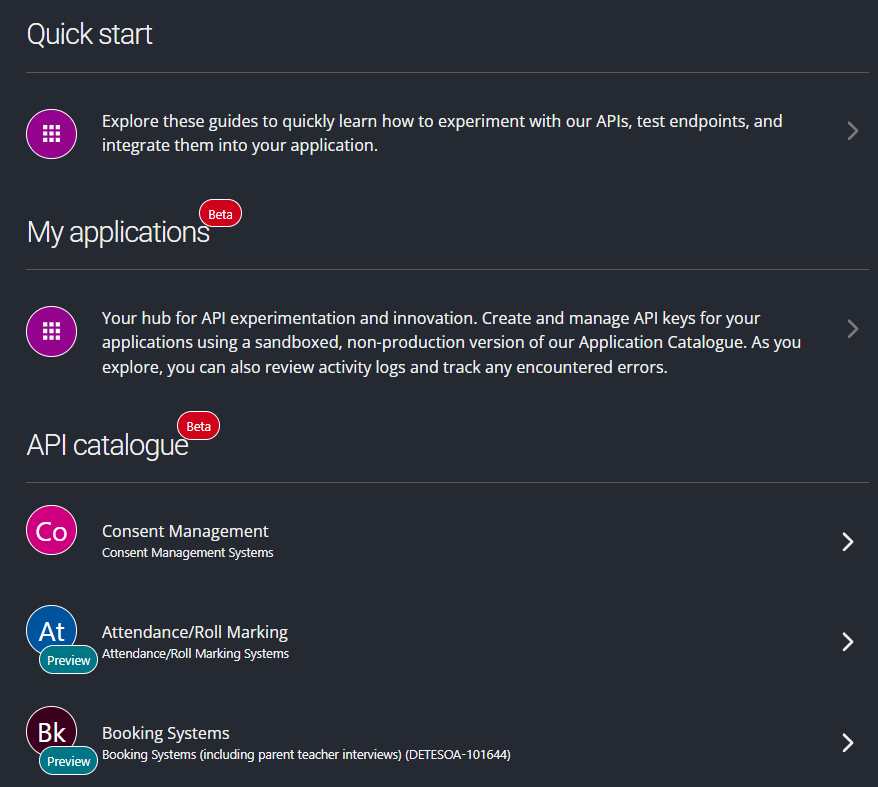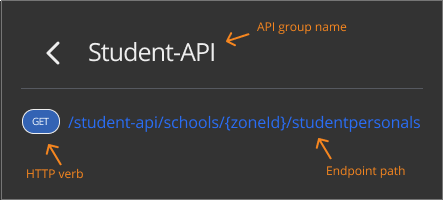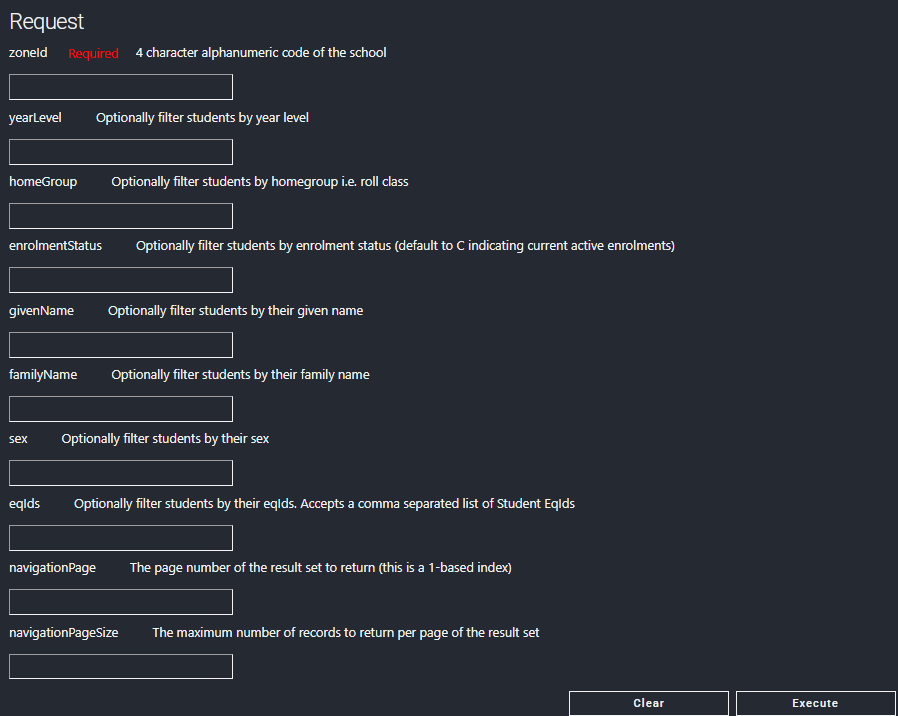Overview
This guide shows you how to explore the API Portal interface and test one of the APIs (in this case, the Student-API endpoint) directly from the sandbox — no code or external tools required.
Step 1: Navigate to the API
- Log in to the Developer Portal.
- Go to the API Catalogue. You will see the following sections:
- Quick start – Guides to help you learn about the API sandbox
- My applications – Create and manage application keys and view activity logs
- API catalogue – APIs exposed by DataHub for Department systems
- QTeachers catalogue – APIs exposed by the QTeachers system
[add screenshot]
- Select one of the system/product groups, e.g., Consent Management.
- You will see a list of API groups and their endpoints. You can download the API specifications by clicking the download icon.
- Locate and click the Student-API group and select the endpoint:
GET/student-api/schools/{zoneId}/studentpersonals
This will take you to the API portal, where you can test the endpoint.

Step 2: Explore the portal interface
The portal interface is divided into several sections:
- Endpoint – Displays the API group name, HTTP verb, and endpoint path

- Model – Shows the data model in JSON format
- Request – Displays input parameters and includes Clear and Execute buttons
- Response – Displays the response from the API in JSON format
Step 3: Explore the model
Expand the Model section to see the structure of the StudentPersonal object returned by this API.
Example schema:
{
"StudentPersonal": [
{
"LocalId": "string",
"StateProvinceId": "string",
"OtherIdList": [
{
"Type": "string",
"Value": "string"
}
],
"PersonInfo": {
"Name": {
"Type": "string",
"FamilyName": "string",
"GivenName": "string",
"PreferredFamilyName": "string",
"PreferredGivenName": "string",
"FullName": "string"
},
"Demographics": {
"BirthDate": "string"
}
},
"MostRecent": {
"SchoolLocalId": "string",
"YearLevel": {
"Code": "string"
},
"Homegroup": "string"
},
"SIF_ExtendedElements": [
{
"Name": "string",
"Text": [
{}
]
}
],
"IndependentStudent": "string",
"MedicalCondition": "string",
"Indigenous": "string"
}
]
}
Understanding the model helps you know what data to expect in the response.
Step 4: Provide input parameters
Scroll to the Request section. You will see a list of input parameters such as:

Enter the required fields (e.g., zoneId = 434972). Optional fields can be left empty unless you want to filter results.
Step 5: Execute the request
Scroll to the Response section. You will see:
- Click Clear to reset any previous input.
- Click Execute to send the request.
The portal will call the API in real time.
Step 6: View the response
Scroll to the Response section. You will see:
- Status code – e.g., 200 OK means the request was successful
- Response body – The JSON data returned by the API
Example response:
{
"StudentPersonal": [
{
"LocalId": "590529",
"StateProvinceId": "QLD",
"OtherIdList": [
{
"Type": "TFN",
"Value": "416665353"
}
],
"PersonInfo": {
"Name": {
"Type": "A",
"FamilyName": "Kuvalis",
"GivenName": "John",
"PreferredFamilyName": "Kihn",
"PreferredGivenName": "Seamus",
"FullName": "Adriana Romaguera"
},
"Demographics": {
"BirthDate": "2021-09-08T04:07:47.303Z"
}
},
"MostRecent": {
"SchoolLocalId": "358588",
"YearLevel": {
"code": "7",
"description": "Year 3"
},
"Homegroup": "Simpsons"
},
"SIF_ExtendedElements": [
{
"Name": "0360669844",
"Text": [
"Some sample text..."
]
}
],
"IndependentStudent": "Y",
"MedicalCondition": "N",
"Indigenous": "Y"
}
]
}
Next steps
Once you have successfully tested the API in the portal, you can:
- Experiment with different parameters – Try different
zoneId,yearLevel, andhomeGroupvalues to explore responses. - Test other endpoints – Explore additional API groups in the portal and understand their models and parameters.
- Integrate into your application – Use the input parameters and response format as a guide to integrate the API in your code or Postman collections.
- Save and share requests – Document the request and response examples for your team.
- Apply for live credentials – Once your testing is complete, request security credentials to interact with live Department systems.
- Monitor and troubleshoot – Review API responses carefully to handle errors, missing data, or permission issues.




